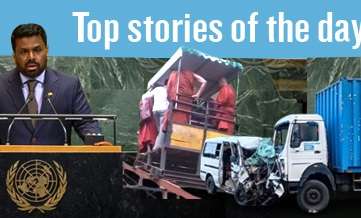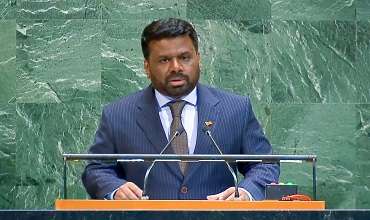The Importance of Environmental Impact Assessments and the Turmoil in our Coasts
The Importance of Environmental Impact Assessments and the Turmoil in our CoastsRecently, Mount Lavinia Beach sparked the attention of the public especially due to a beach nourishment project that commenced amidst curfew. Significantly, at the center of this entire episode is the Director General of the Coast Conservation and Coastal Resource Management Department (CCD) who quite dubiously admitted that no Environmental Impact Assessment was done prior to the commence of this project. Before one dwells into the implications surrounding his statement, it is pertinent to understand what the EIA framework constitutes in light of environmental conservation and sustainable development.
What is an Environmental Impact Assessment?
Environmental Impact Assessment or EIA is a process of assessing the potential socio-environmental impact of any development proposal aiming to change a natural landscape. It embodies the identification and suggestion of measures to minimise the likely negative impact of the said project, as well as to recommend steps to enhance the potential positive impact.
According to Article 17 of the Rio Declaration, an EIA is defined as a national instrument, which is undertaken for proposed activities that are likely to have a significant adverse impact on the environment and are subject to a decision of a competent national authority. Simply put this is founded on the "precautionary principle", which stipulates that if there is an element of uncertainty with regard to the environmental harm that may be caused by a proposed project, the precautionary approach of "better being safe than sorry" is applied by states to prevent irreversible environmental degradation.
Further, according to Article 14 of the Convention on Biological Diversity, which Sri Lanka ratified in 1994, EIAs should be introduced due to two main reasons: firstly to avoid or minimize adverse effects and; secondly to allow for public participation in such EIA procedures.
In Sri Lanka, the EIA process was first mandated for large scale developmental projects located in sensitive ecosystems by gazette no. 772/22 of 1993. This gazette also specified the types of projects falling under the EIA requirement. If there is no complex environmental impact, an IEE (Initial Environmental Examination) can be prescribed instead of an EIA.
If a project is outside the coastal zone, then it falls under the ambit of the Central Environmental Authority. However, if the project is located within the coastal zone, such as in the aforementioned case in Mount Lavinia, the duty of identifying whether a project requires an EIA is vested with the Director General of the CCD. This is according to section 14 of the Coast Conservation and Coastal resources management Act no. 57 of 1981. Section 14(1) mandates a permit from the Director General for any development activity proposed. The Director General has the discretion thus, to prescribe projects which do not require EIAs.
In any case, EIA is a process. It involves two main types of actors: project proponent (PP) and the Project Approving Agencies (PAAs). The PAAs are EIA administrative agencies that are responsible for guiding the EIA for projects and for issuing EIA approval or rejection. This process encompasses six key stages: (i) screening or determining whether an EIA / IEE is required for a project (ii) scoping or determining the scope of the EIA / IEE study and issuing of Terms of Reference (iii) preparation of the EIA / IEE report (iv) review of the report (by the public and the PAA) (v) approval with terms and conditions or rejection with reasons (vi) post-approval monitoring.
It should be noted that the review of the EIA encompasses both a public as well as a technical review of the impact assessment. In fact, EIA reports are specifically required to be open for public inspection and comment for a mandatory period of 30 days. Once the review is completed, the project proponent should respond to the public comments received. This underpins a framework of assessment which inculcates the broader socio-environmental impacts of the proposal. Thus, it is safe to say that EIAs are almost like maps fundamental to better navigate any proposed project. Due to this very reason, the Australian EIA network highlights the fundamental purpose of an EIA as a mode of informing the decision-makers of the likely impact of a proposal before a decision is made. Much of the dismay surrounding the present issue in Mount Lavinia is largely centered around the lack of such impact assessment made before the initiation of the project.
No EIA or even an IEE in Mount Lavinia - Why is this Problematic?
As reported by the media on the 19th of April 2020, the Director General of CCD claimed that an environmental impact assessment report has been obtained for the project that was still ongoing at the time and dismissed any concerns that may arise on the impact to the environment. Contradicting himself and much to the confusion of concerned citizens, he later told the media that neither an IEE or an EIA had been conducted and continued to justify the failure to conduct an EIA by emphasizing the need for a “soft solution” to prevent coastal erosion, boost tourism and support the fishing industry.
When retracing to the point of project approval, it is interesting to note that the CCD is both the project proponent and the PAA in the Mount Lavinia beach nourishment project. Whilst, this is in juxtaposition to the principle of natural justice "nemo judex in causa sua" (no one is judge in his own case); it also questions the discretion of the Director General in terms of prescribing EIAs. While the Act may provide the discretionary power to the Director General to decide whether an IEE or an EIA is best, in Environmental Foundation Ltd v. Mahaweli Authority of Sri Lanka (2010 1 SLR 1) the court upheld the view that agencies of the State are to be guided by directive principles and fundamental duties of the Constitution when carrying out their statutory and regulatory duties. Article 27(14) of the Constitution embodies the directive principles of state policy where the state is to protect, preserve and improve the environment. Article 28 refers to the fundamental duty upon every person in Sri Lanka to protect nature and conserve its riches. Thus, the CCD is no exception and cannot evade this duty.
Undoubtedly, the filling of sand entirely changes the landscape of the iconic Mount Lavinia beach, which is also known as Galkissa, derived from GalVissa - meaning 20 boulders. While the impact of the seasonal erosions, now worsening due to natural phenomena as well as unmanaged developments and population growth is a cause for concern, the severity of the erosion spoken of with regards to the Mount Lavinia beach is debatable as century-old photos of the area are no different to what appeared prior to the nourishment. Had there been an EIA which would include a description of the existing environment and the project justification, it could have been concluded that such a drastic preventative measure was indeed required.
The Director General publicly acknowledged that an EIA was not prescribed by virtue of the beach nourishment project being a soft solution to coastal erosion. On the one hand, whether a costly beach nourishment, that is claimed to last only for four years is in fact the best soft solution is uncertain. On the other hand, soft solutions of this nature are means of utilizing the natural environment to prevent coastal erosion. Among them are other viable alternatives such as mangrove preservation and planting and coral reef preservation and enhancement. Hard solutions, in contrast, involve rock, cement or steel to build structures like revetments, sea walls or groynes. Once again, in the absence of an EIA which would mention the possible alternatives, the public has been denied this information and the ability to comment on their concerns within the 30 day period. EIAs enable the evaluation of the socio-economic impact of a project due to the inclusive review process accompanying opinions of stakeholders ranging from industries to residents potentially affected by the project. Hence, without an EIA it is difficult to prove the claims made by the authorities, especially of boosted tourism and benefits to the fishing industry that beach nourishment would bring.
Noteworthily, the Western coastal areas in Sri Lanka are the most common sea turtle nesting grounds for five out of the seven species of sea turtles. These endangered species constitute the very biodiversity that the Fauna and Flora Ordinance intends to protect. The coral reefs that dissipate wave energy and act as a natural prevention to coastal erosion, and the shipwrecks that not only make popular diving sites, but provide fish breeding grounds are among the many coastal ecosystems that could be negatively impacted through projects of this nature. Going in blind without assessing adverse environmental impacts and mitigation measures; and by relegating conservation of such invaluable ecological resources to the lowest of priorities leaves very little space for environmental conservation and sustainable development. Ironically, CCD is termed the “Coast Conservation and Coastal Resource Management Department” although its actions are evidently quite aversive to what the name entails.
Way Forward: EIAs for Sounder Decision Making
Thus, the issue of coastal erosion in Mount Lavinia is now spiralling into a tangled list of unanswered questions due to the lack of an EIA. However, there are two key issues which cannot be left in confusion surrounding the turmoil. Firstly, the issue of the CCD being both the PP and the PAA is deeply concerning as it clearly violates the very principles of natural justice. Secondly, the fact that a beach nourishment project facilitated by a mammoth of public funds without an EIA or at least an IEE is even more problematic. The statement made by Justice Amerasinghe in the Bulankulama v. Ministry of Industrial Development case (2000 3 SLR 243) shares some valuable insight in respect of these concerns. According to his Lordship, “...EIAs are intended to foster sound decision making, not to generate paperwork. The EIA process should also help public officials make decisions that are based on understanding environmental consequences and take actions that protect, restore and enhance the environment.” In this light, although anthropogenic climate change is one of the biggest challenges facing this century; it is alarming to witness the lack of diligence on the part of the very authorities primarily vested with the duty of preventing and mitigating its adverse impact.
By : Piyumani Ranasinghe and Maleesha Gunawardana

-
Still No Comments Posted.














Leave Comments